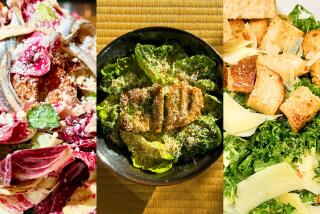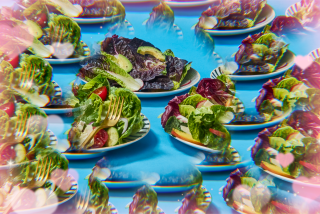Fresh From the Bag
- Share via
The latest fast-food craze is happening in the produce section of supermarkets.
See-through bags of sliced or mini carrots, mixed greens, broccoli florets, shredded cabbage and a host of other ready-to-dress salads and ready-to-cook vegetables have elbowed their way on to shelves alongside the untrimmed heads of lettuce and cabbage, whole carrots and celery stalks. And this fresh-cut produce, as the industry refers to vegetables that are cut and bagged for sale, is the fastest-growing segment of the food industry.
If you can open plastic, you can enjoy fresh vegetables at a moment’s notice. This has proved a boon to working parents who have little time to spend chopping and slicing for family meals and for dieting consumers who long for variety in low-fat convenience foods.
Sales of packaged salad, a category that barely existed five years ago, reached $889 million in 1995. Total sales of pre-cut food are expected to more than triple, from $5.2 billion in 1994 to $19 billion in 1999, industry analysts say.
This month, several products are expected to debut. Fresh Express, a maker of bagged ready-to-eat salad, has joined with Hillshire Farms, manufacturer of processed meats, to produce a line of single-serving meals such as chicken Caesar salad and a chef’s salad with sliced turkey and ham. Tanimura & Antle, a California company, packages vegetables with free toys for children and is introducing a salad-in-a-bowl with croutons and salami.
But is packaged produce really safe? How do processors keep vegetables “fresh”? Do they have the same vitamins and nutrients as whole, unwashed, uncut vegetables?
A scientist at the University of Kentucky has studied the vitamin and nutrient contents of cut and bagged vegetables. She compared bagged broccoli florets with broccoli stalks that were cut at the same time and found that the florets stayed fresher and contained 15% more vitamin C. Likewise, the mini carrots in a bag retained 100% of the cancer-fighting beta carotene compared with a bunch of whole of carrots, which lost beta carotene with time.
The key, said Margaret Barth, professor of food and nutrition studies at the University of Kentucky, is the processing that fresh-cut produce undergoes. To prolong the shelf life of vegetables, processors have developed a way of putting produce in a state of hibernation by keeping it very cold and by packing it in an atmosphere low in oxygen.
The air inside bags of fresh-cut vegetables contains a much lower level of oxygen than the air we breathe, which is about 21% oxygen. Depending on the vegetable, the air inside the packed bags of fresh-cut produce is about 5% oxygen. That same atmosphere is credited with retaining vitamins and nutrients, Barth said.
Keeping vegetables fresh during shipping and on the shelf has been a decades-old problem for produce growers in Salinas, where much of the vegetables and 80% of the country’s broccoli are grown. John Steinbeck even mentioned the heartbreaking efforts of one family to keep lettuce fresh on its way from Salinas to New York in his novel “East of Eden.”
It wasn’t until the late 1980s that the industry started to devise ways to make vegetables easier to keep and to transport, said Edith Garrett, president of the International Fresh-Cut Produce Assn. The development of new methods of shipping was fueled by the demand from fast-food chains, such as McDonald’s and Burger King, which use enormous amounts of cut lettuce, sliced tomatoes and diced onions. Many companies that supply these prepared vegetables to fast-food chains are providing fresh-cut produce to retail consumers.
Today, vegetables are cut and washed in a solution of chlorine that kills surface bacteria. The produce is dried and packed into “breathable” bags that allow carbon dioxide to escape. And the bags are filled with a mixture of air that is low in oxygen. It is shipped at 40 degrees or less and kept cold in refrigerated trailers.
“Our slogan is, ‘Keep it cold, keep it clean and keep it moving,’ ” said Chris Nelson, vice president of Ready Pac in Irwindale. “We have to protect what we call the ‘cold chain’ to make sure it’s as good on the eighth or ninth day as it was on the first day it was packed.”
Manny Costa, who owns Costa Fruit & Produce Co. in Boston and is the chairman of the International Fresh-Cut Produce Assn., said it wasn’t until major companies like Dole and Fresh Express entered the market that the industry took off. “They were the ones that invested in promoting this as a healthier, nutritious food,” he said.
That message is offset by the fact that fresh-cut produce can cost four times what the greens would cost if consumers did their own washing, drying and cutting. Fresh Express’ Caesar Salad, for example, costs $2.49 for a 6-ounce bag of romaine lettuce, which is packaged with cheese-garlic croutons and dressing. A head of unwashed, uncut romaine costs about $1.49 a pound.
Fresh-cut products on the supermarket shelves include Dole’s line of salads with condiments--Caesar salad with croutons, spinach salad with bacon bits, Oriental salad with crisp noodles. Mann Packing in Salinas offers shredded broccoli stems and a broccoli and carrot combination. Coronet Foods of Wheeling, W. Va., makes a line of “soup-and-salad” meals, combining the mixed greens with packets of soup concentrates.
This year, for the first time since the boom in the ‘90s, sales of salad mixes began to level off. But industry leaders are looking ahead to the new growth area, which they believe is fresh-cut fruit. Bill Hammonds, chairman of Gold Rush Produce in Firebaugh, said his 100-year-old family business is preparing to make changes.
“It’s obvious where our business is going to go,” he said. But the technology for keeping fruit fresh is young and completely different from the technology involved in vegetables. “It isn’t in its infancy,” Hammond said. “It’s prenatal. Fruit is very temperature sensitive and more susceptible to bacterial contamination.”
More to Read
Eat your way across L.A.
Get our weekly Tasting Notes newsletter for reviews, news and more.
You may occasionally receive promotional content from the Los Angeles Times.










